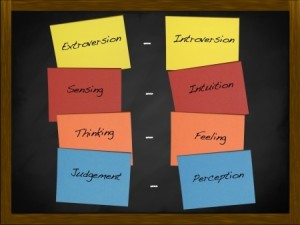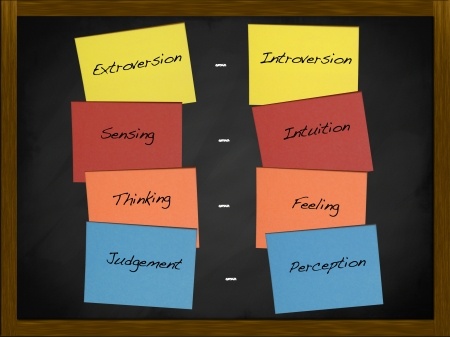
I’ve been uneasy with the Myers-Briggs Type Inventory (MBTI) for a long time, especially after I read a few biographies about Carl Jung. Simply put, I find the man’s psychological theories bizarre and his lifestyle unethical. The Myers-Briggs is based upon Jung’s work on personality types, so my uneasiness with it stems from that association. However, the MBTI is so pervasive, I’ve found myself in circumstances over the years where I completed it once or twice. Sorry, I can’t tell you what my type was. But my astrological sign is Gemini. And from what I’ve come to learn, they both mean about the same thing—nothing much.
In The Cult of Personality Testing, Annie Murphy Paul said: “Perhaps no other personality test has achieved the cult status of the Myers-Briggs Type Indicator.” An article on Vox by Joseph Stromberg titled: Why the Myers-Briggs test is meaningless and one by Drake Baer for Business Insider noted how the Myers-Briggs has become entrenched within the business culture. Almost 90 Fortune 100 companies use it; over 2.5 million people a year take it. MBTI: Roots Unearthed said over 10,000 companies, 2,500 colleges and 200 USA government agencies (including the State Department, the CIA and the military) use the MBTI. Its been estimated to have been administered to 50 million people since the 1960s.
Murphy Paul noted that scientific psychology has taken issue with the Myers-Briggs from its beginning in the 1940s. And that skepticism has only grown stronger since then. She reported that one study, conducted by pro-MBTI supporters, found that more than half of individuals who took the Myers-Briggs were given a different type when they took the test a short while later. Another study discovered that individuals’ types could change even according to the time of day it was.
Even when an individual consistently attains the same type, that designation may not mean much. While there is limited scientific support for some of Myer’s basic dimensions (people do seem to differ in their relative levels of introversion or extroversion, for example), there is no evidence that her sixteen distinct types have any more validity than the twelve signs of the zodiac. And research has found little connection between Indicator types and real-life outcomes. There is scant evidence that MBTI results are useful in determining managerial effectiveness, helping to build teams, providing career counseling, enhancing insight into self or others, or any other of the myriad uses for which it is promoted.
Adam Grant, an organizational psychologist at the University of Pennsylvania, is concerned with “the cultlike devotion of many consultants and practitioners to it without [examining] the evidence.” In “Say Goodbye to MBTI, the Fad that Won’t Die,” he noted the MBTI test wasn’t reliable, valid or independent; nor was it comprehensive. These four standards are used in social sciences to assess whether the categories of the MBTI, and other social science assessment tools, are meaningful. He quoted Murphy Paul as saying that “the sixteen distinct types described by the Myers-Briggs have no scientific basis whatsoever.”
Drake Baer reported that Gardner and Martinko found few consistent relationships between type and managerial effectiveness. In “The Utility of the Myers-Briggs Type Indicator,” David Pittenger did a review of the available literature on the MBTI and concluded: “it suggests that there is insufficient evidence to support the tenets of and claims about the utility of the test.” There are studies supporting the reliability and usefulness of the MBTI. But as Murphy Paul pointed out, many of these were published in specialty journals about the MBTI or Jung’s psychological types.
Many others appear in books produced by CPP, the Indicator’s distributor. And most research on the Myers-Briggs is concerned with exploring applications for the test — not with proving or refuting its basic legitimacy.
Anna North reported for The New York Times, that CPP makes $20 million annually on the Myers-Briggs and related products. She said part of the test’s influence comes from how it is marketed. Once someone becomes a certified test administrator (after paying $1,700 for a four-day training), they can promote themselves as a career coach to both individuals looking for work and companies that use the test. It then costs between $15 and $40 to take the test. And the only way to take the test is through a certified administrator. “In short, CPP makes money off the test taker and the test giver.” Lillian Cunningham reported for The Washington Post that in 2011, 2,500 Americans became certified to administer the Myers-Briggs.
When Jung published his book, Psychological Types, in 1921, he suggested that people fell roughly into two main types: perceivers and judgers. Perceivers could be further split into sensors or intuitors. Judgers could be separated into thinkers or feelers. All four types could then be further divided on attitudes into introverts and extraverts. Jung’s work on personality types was adapted into a test by Katherine Myers and her daughter Isabel Briggs, two Americans with no formal training in psychology. Briggs was a housewife with a deep interest in Jung. Myers wrote mystery novels before developing the prototype for the Myers-Briggs. They began testing their “Type Indicator” in 1942.
One of the major problems with the MBTI is that it uses behavioral binaries for its categories: extraverted or introverted; sensing or intuiting; thinking or feeling; and judging or perceiving. Additionally, its items are similarly constructed. For example, one item says: “You tend to sympathize with other people,” to which you answer either “yes” or “no.” Adam Grant was quoted in Vox as saying: These categories all create dichotomies, but the characteristics on either end are either independent from each other, or sometimes even go hand-in-hand.” David Pittenger showed that even data from the Myers-Briggs itself indicated most people were in the middle for any given category, but become pigeonholed in one or the others by the forced choice items.
Fittingly, the last word here on the Myers-Briggs comes from Jung himself, who said: “Every individual is an exception to the rule.” So trying to fit individuals into a rigid system was futile, according to Jung. Sticking labels on people at first sight, as is done with the MBTI, is “nothing but a childish parlor game.”





